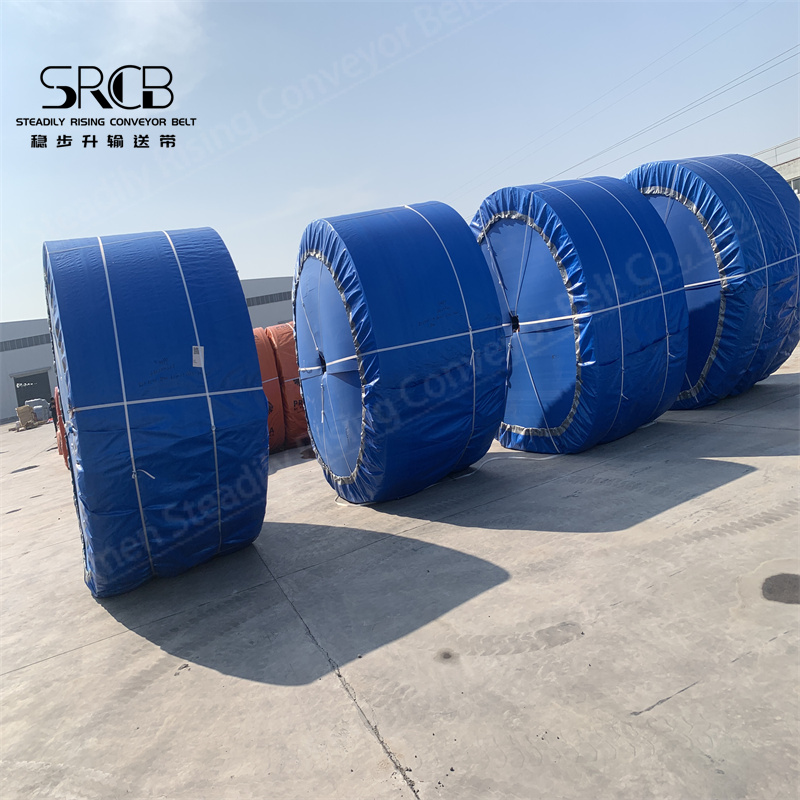
How many types of conveyor belts
2024-06-18 17:23In June 2024, our company shipped a 108-meter nylon conveyor belt with a bandwidth of 1200mm to a cement plant in Argentina for the transportation and delivery of cement.
The conveyor belt is a mechanical device widely used in the industrial field. Its main functions include: material transportation, material lifting, material accumulation, material classification, garbage cleaning, operating safety, and improving efficiency.
Conveyor belt is one of the extensively applied logistics equipment in modern industry. It could transferred materials form one place to another place to realize the automatic transmission and handling of materials. There are many types of conveyor belts, they could be classified by different ways.
According to the materials, conveyor belts could be divided into vulcanized rubber conveyor belt, silicon rubber conveyor belt, PVC conveyor belt, PU conveyor belt.
Vulcanized rubber conveyor belt has relevant great oil resistant, high temperature resistance that suits for conveying some relatively rough materials such as coal, ore, etc.,
Silicone rubber conveyor belt has excellent high temperature resistance, aging resistance property suits for conveying food, hygiene requirements.
PVC conveyor belt has good wear resistance, corrosion resistance are suitable for conveying some acid and alkali materials.
PU conveyor belt with good wear resistance, high temperature resistance applied for conveying some high strength and high speed transmission materials.
According to the structural method, conveyor belts could be divided into trough conveyor belts, flat conveyor belt, uphill conveyor belt, bend conveyor belt, telescopic conveyor belt, etc.
Trough conveyor belt has ability to better fix the materials on the conveyor belt suits for conveying some materials that easy to roll.
Flat conveyor belt suits for conveying some flat materials.
Uphill conveyor belts could realize the climbing transmission of materials, suits for some places where need to be inclined transmission; bending conveyor belt could fulfill some occasions that need to change the transmission direction.
Telescopic conveyor belt is able to be extended and retracted according to needs suit for some occasions that need to adjust the length.
In addition, conveyor belt could be divided into flat conveyor belts, transition belts, roller conveyor belts, mesh conveyor belt, grill conveyor belts and other types.
Flat conveyor belt are usually used for transmission of light materials.
Transition belts usually used for connecting two different kinds of conveyor belts, roller conveyor belts.
Roller conveyor belts usually applied for transmission of heavy materials.
Mesh conveyor belts usually used for high temperature or corrosive ambient materials transmission.
Grill conveyor belts usually used for grading and screening materials.
Besides the above classification methods, conveyor belts could be classified through the function and purpose such as assembly line conveyor belt, food grade conveyor belt, climbing conveyor belt, turning conveyor belt.
Assembly conveyor belt is one of the commonly used transmission equipment on the industrial line which can achieve the automatic transmission and handling of materials.
Food grade conveyor belt could meet the requirements of food hygiene, and it is suitable for food processing and packaging industry.
Climbing conveyor belt is able to accomplish the climbing transmission of materials and it is suitable for occasions that require inclined transmission.
Turning conveyor belt can realize the turning transmission of materials and is suitable for some places where need to change the transmission direction.
When selecting the conveyor belt, need to consider comprehensively according to the actual needs and application occasions.
Firstly, need to consider the type and the transported distance of the materials that on the conveyor belt, select the appropriate materials and the structural method.
Second, think about the size and the width of the conveyor belt, based on the actual needs to choose the properly size and the width.
Finally, considering the drive methods and the speed of the conveyor belt, choose the most corresponding drive methods and the speed control methods.
All in all, when choosing the conveyor belt, should based on the actual demands and application scenarios to have a comprehensively consideration, choose the appropriate types and materials to meet different transportation requirements. Meanwhile, need to pay attention to the maintenance in daily use, regularly inspect and repair the transmission equipment to ensure its could be operated normally and using life.

